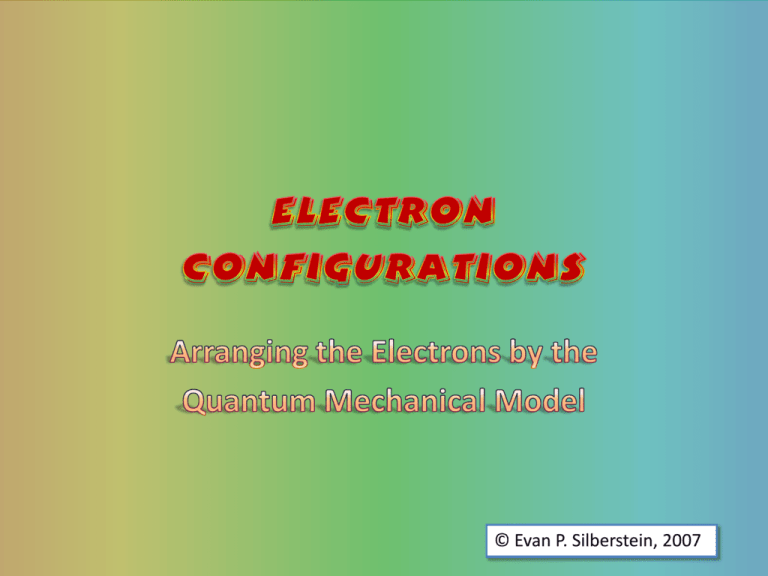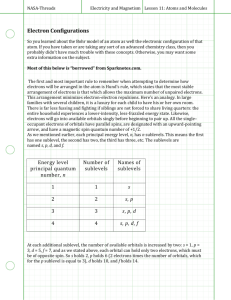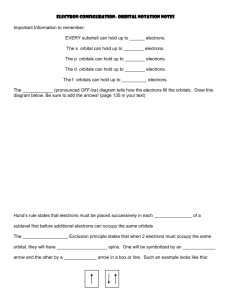Electron Configurations - Evan's Regents Chemistry Corner
advertisement

© Evan P. Silberstein, 2007 • The Aufbau Principle − electrons fill orbitals starting at the lowest available energy state before filling higher states. • Hund’s Rule − unoccupied orbitals of a given energy will be filled before occupied orbitals of the same energy are reused. (like seats on a bus) • The Pauli Exclusion Principle − no two electrons in an atom can occupy the same quantum state. (be in the same orbital and have the same spin) o An orbital can hold a maximum of two electrons • The first energy level has only one sublevel, s; the second energy level has two sublevels, s and p; the third energy level has three sublevels, s, p, and, d; and so on. • There is 1 s orbital, 3 p orbitals, 5 d orbitals, 7 f orbitals, and so on. • There are a maximum of two electrons per orbital. • Using this information, can you fill in the table below? Number of Orbitals ( n2 ) s p d f g h i 1 3 5 7 9 11 13 Maximum Number of Electrons (2n2 ) 1 1 2 − − − − − − 2 2 4 2 6 − − − − − 8 3 9 16 2 2 6 6 10 10 − 14 − − − − − − 18 32 2 6 10 14 18 − − (50) 6 25 36 2 6 10 14 18 22 − (72) 7 49 2 6 10 14 18 22 26 (98) Electrons in Each Location Principal Energy Level (n) 4 5 Electrons per Sublevel • Each floor is like an energy level. (1-7) • Each apartment is like a sublevel. (s, p, d, or f) o Higher energy levels are larger, so they have more sublevels The first level (floor) has one sublevel (apartment) − s The second has two − s and p And so on • Each bedroom is like an orbital. o “s” apartments have one bedroom o “p” apartments have three bedrooms o “d” apartments have five bedrooms, and o “f” apartments have seven bedrooms • Imagine electrons are moving into the apartment complex pictured below: o Electrons don’t like to waste energy climbing to apartments on higher floors. o Electrons don’t like to waste energy caring for larger apartments. o Electrons move into the most energy efficient apartments first. • In what order do the apartments fill up? • The electrons are arranged according to the following rules: o the number of electrons equals the number of protons (atomic number) o electrons occupy orbitals 1s2 in sequence beginning with 2s2 2p6 those of the lowest energy. 3s2 3p6 3d10 o in a given sublevel, a second 4s2 4p6 4d10 4f14 electron is not added to an 5s2 5p6 5d10 5f14 orbital until each orbital in the sublevel contains one 6s2 6p6 6d10 electron. 7s2 7p6 • One consequence of the order of filling is that an outer shell never has more than eight electrons. • Consider the element scandium shown below: 44.9559 +3 Sc 21 2-8-9-2 • What do the rules for the order of filling show about the electron configuration? o First 1s fills with 2 electrons leaving 19 o Second 2s fills with 2 electrons leaving 17 o Next 2p fills with 6 electrons followed by 3s with 2 electrons leaving 9 o Then 3p fills with 6 electrons followed by 4s with 2 electrons leaving 1 o Finally the remaining electron goes into 3d 1s 2s 2p 3s 3p 4s • This gives an electron configuration of 1s22s22p63s23p64s23d1. 3d • Sublevel Notation: sublevel notation shows how many electrons are in each sublevel 1s22s22p63s23p64s23d1 • Bohr Notation: Bohr notation shows the number of electrons in each shell or energy level 2 −8−9−2 • Orbital Notation: Orbital notation shows the electrons and their spin in each orbital ↑↓ ___ ↑↓ ___ ↑↓ ___↑↓ ___ ↑↓ ___ ↑↓ ___ ↑↓ ___↑↓ ___↑↓ ___ ↑↓ ___ ↑ ___ ___ ___ ___ ___ 1s 2s 2p 3s 3p 4s 3d • Step 1: Determine the sublevel notation of iron o 1s has room for 2 electrons, leaving 24. o 2s has room for 2 electrons, leaving 22. o 2p has room for 6 electrons and 3s has room for 2 more, leaving 14. o 3p has room for 6 electrons and 4s has room for 2 more, leaving 6. o 3d has room for the remaining 6 o The electron configuration is 1s22s22p63s23p64s23d6. 1s 2s 2p 3s 3p 3d 4s • Step 2: Use the information from the sublevel notation to draw the orbital notation o Draw a horizontal line to represent each orbital in a sublevel, and label it. o Add one electron at a time to each orbital, represented by an up or down arrow, in the same order as in the sublevel notation. Electrons in an orbital must have opposite spins (arrows in opposite directions). Follow Hund’s rule. Do not begin pairing electrons in an orbital until all the orbitals in a sublevel have an electron ↑↓ ↓↑ ↓↑ ↓ ↑↓ ↓↑ ↓↑ ↓ ↑↓ ↓↑ ___ ↑↓ ___ ↑ ___ ___ ___ ___ ↑ ___ ___ ___ ___ ↑ ___ ___↑ ___↑ ___↑ ___ 1s 2s 2p 3s 3p 4s 3d • Draw the sublevel notation by following the order of filling. • Draw the Bohr notation by adding together all the electrons in the same energy level. 1s2 2s2 2p6 3s2 3p6 3d10 4s2 4p6 4d10 4f14 5s2 5p6 5d10 5f14 6s2 6p6 6d10 7s2 7p6 • Draw the orbital notation by taking the information from the sublevel notation.






